毕业设计论文中英文翻译要求(最新)
本科毕业设计(论文)外文翻译基本规范
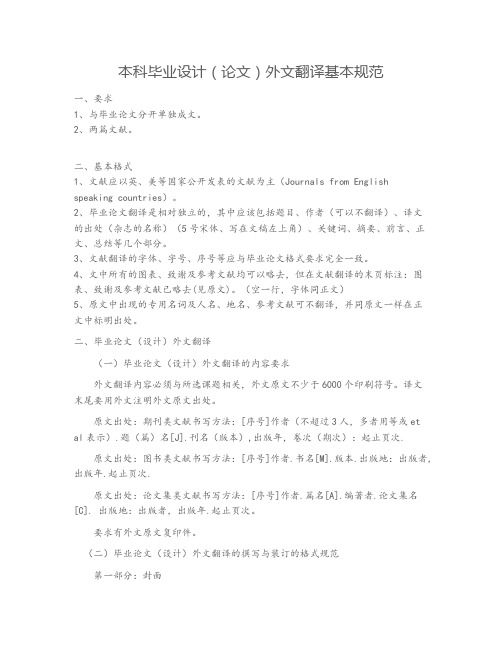
本科毕业设计(论文)外文翻译基本规范一、要求1、与毕业论文分开单独成文。
2、两篇文献。
二、基本格式1、文献应以英、美等国家公开发表的文献为主(Journals from English speaking countries)。
2、毕业论文翻译是相对独立的,其中应该包括题目、作者(可以不翻译)、译文的出处(杂志的名称)(5号宋体、写在文稿左上角)、关键词、摘要、前言、正文、总结等几个部分。
3、文献翻译的字体、字号、序号等应与毕业论文格式要求完全一致。
4、文中所有的图表、致谢及参考文献均可以略去,但在文献翻译的末页标注:图表、致谢及参考文献已略去(见原文)。
(空一行,字体同正文)5、原文中出现的专用名词及人名、地名、参考文献可不翻译,并同原文一样在正文中标明出处。
二、毕业论文(设计)外文翻译(一)毕业论文(设计)外文翻译的内容要求外文翻译内容必须与所选课题相关,外文原文不少于6000个印刷符号。
译文末尾要用外文注明外文原文出处。
原文出处:期刊类文献书写方法:[序号]作者(不超过3人,多者用等或et al表示).题(篇)名[J].刊名(版本),出版年,卷次(期次):起止页次.原文出处:图书类文献书写方法:[序号]作者.书名[M].版本.出版地:出版者,出版年.起止页次.原文出处:论文集类文献书写方法:[序号]作者.篇名[A].编著者.论文集名[C]. 出版地:出版者,出版年.起止页次。
要求有外文原文复印件。
(二)毕业论文(设计)外文翻译的撰写与装订的格式规范第一部分:封面1.封面格式:见“毕业论文(设计)外文翻译封面”。
普通A4纸打印即可。
第二部分:外文翻译主题1.标题一级标题,三号字,宋体,顶格,加粗二级标题,四号字,宋体,顶格,加粗三级标题,小四号字,宋体,顶格,加粗2.正文小四号字,宋体。
第三部分:版面要求论文开本大小:210mm×297mm(A4纸)版芯要求:左边距:25mm,右边距:25mm,上边距:30mm,下边距:25mm,页眉边距:23mm,页脚边距:18mm字符间距:标准行距:1.25倍页眉页角:页眉的奇数页书写—浙江师范大学学士学位论文外文翻译。
英文文献及中文翻译撰写格式

关于毕业设计说明书(论文)英文文献及中文翻译撰写格式为提高我校毕业生毕业设计说明书(毕业论文)的撰写质量,做到毕业设计说明书(毕业论文)在内容和格式上的统一和规范,特规定如下:一、装订顺序论文(设计说明书)英文文献及中文翻译内容一般应由3个部分组成,严格按以下顺序装订。
1、封面2、中文翻译3、英文文献(原文)二、书写格式要求1、毕业设计(论文)英文文献及中文翻译分毕业设计说明书英文文献及中文翻译和毕业论文英文文献及中文翻译两种,所有出现相关字样之处请根据具体情况选择“毕业设计说明书” 或“毕业论文”字样。
2、毕业设计说明书(毕业论文)英文文献及中文翻译中的中文翻译用Word 软件编辑,英文文献用原文,一律打印在A4幅面白纸上,单面打印。
3、毕业设计说明书(毕业论文)英文文献及中文翻译的上边距:30mm;下边距:25mm;左边距:3Omm;右边距:2Omm;行间距1.5倍行距。
4、中文翻译页眉的文字为“中北大学2019届毕业设计说明书” 或“中北大学××××届毕业论文”,用小四号黑体字,页眉线的上边距为25mm;页脚的下边距为18mm。
5、中文翻译正文用小四号宋体,每章的大标题用小三号黑体,加粗,留出上下间距为:段前0.5行,段后0.5行;二级标题用小四号黑体,加粗;其余小标题用小四号黑体,不加粗。
6、文中的图、表、附注、公式一律采用阿拉伯数字分章编号。
如图1.2,表2.3,附注3.2或式4.3。
7、图表应认真设计和绘制,不得徒手勾画。
表格与插图中的文字一律用5号宋体。
每一插图和表格应有明确简短的图表名,图名置于图之下,表名置于表之上,图表号与图表名之间空一格。
插图和表格应安排在正文中第一次提及该图表的文字的下方。
当插图或表格不能安排在该页时,应安排在该页的下一页。
图表居中放置,表尽量采用三线表。
每个表应尽量放在一页内,如有困难,要加“续表X.X”字样,并有标题栏。
毕业设计(论文)外文资料和译文格式要求(模板)
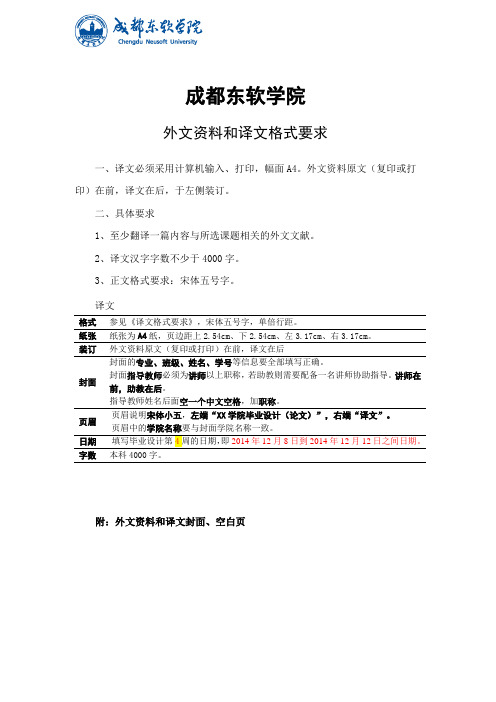
成都东软学院外文资料和译文格式要求一、译文必须采用计算机输入、打印,幅面A4。
外文资料原文(复印或打印)在前,译文在后,于左侧装订。
二、具体要求1、至少翻译一篇内容与所选课题相关的外文文献。
2、译文汉字字数不少于4000字。
3、正文格式要求:宋体五号字。
译文格式参见《译文格式要求》,宋体五号字,单倍行距。
纸张纸张为A4纸,页边距上2.54cm、下2.54cm、左3.17cm、右3.17cm。
装订外文资料原文(复印或打印)在前,译文在后封面封面的专业、班级、姓名、学号等信息要全部填写正确。
封面指导教师必须为讲师以上职称,若助教则需要配备一名讲师协助指导。
讲师在前,助教在后。
指导教师姓名后面空一个中文空格,加职称。
页眉页眉说明宋体小五,左端“XX学院毕业设计(论文)”,右端“译文”。
页眉中的学院名称要与封面学院名称一致。
字数本科4000字。
附:外文资料和译文封面、空白页成都东软学院外文资料和译文专业:软件工程移动互联网应用开发班级:2班姓名:罗荣昆学号:12310420216指导教师:2015年 12月 8日Android page layoutUsing XML-Based LayoutsW hile it is technically possible to create and attach widgets to our activity purely through Java code, the way we did in Chapter 4, the more common approach is to use an XML-based layout file. Dynamic instantiation of widgets is reserved for more complicated scenarios, where the widgets are not known at compile-time (e g., populating a column of radio buttons based on data retrieved off the Internet).With that in mind, it’s time to break out the XML and learn how to lay out Android activities that way.What Is an XML-Based Layout?As the name suggests, an XML-based layout is a specification of widgets’ relationships to each other—and to their containers (more on this in Chapter 7)—encoded in XML format. Specifi cally, Android considers XML-based layouts to be resources, and as such layout files are stored in the res/layout directory inside your Android project.Each XML file contains a tree of elements specifying a layout of widgets and their containers that make up one view hierarchy. The attributes of the XML elements are properties, describing how a widget should look or how a container should behave. For example, if a Button element has an attribute value of android:textStyle = "bold", that means that the text appearing on the face of the button should be rendered in a boldface font style.Android’s SDK ships with a tool (aapt) which uses the layouts. This tool should be automatically invoked by your Android tool chain (e.g., Eclipse, Ant’s build.xml). Of particular importance to you as a developer is that aapt generates the R.java source file within your project, allowing you to access layouts and widgets within those layouts directly from your Java code. Why Use XML-Based Layouts?Most everything you do using XML layout files can be achieved through Java code. For example, you could use setTypeface() to have a button render its textin bold, instead of using a property in an XML layout. Since XML layouts are yet another file for you to keep track of, we need good reasons for using such files.Perhaps the biggest reason is to assist in the creation of tools for view definition, such as a GUI builder in an IDE like Eclipse or a dedicated Android GUI designer like DroidDraw1. Such GUI builders could, in principle, generate Java code instead of XML. The challenge is re-reading the UI definition to support edits—that is far simpler if the data is in a structured format like XML than in a programming language. Moreover, keeping generated XML definitions separated from hand-written Java code makes it less likely that somebody’s custom-crafted source will get clobbered by accident when the generated bits get re-generated. XML forms a nice middle ground between something that is easy for tool-writers to use and easy for programmers to work with by hand as needed.Also, XML as a GUI definition format is becoming more commonplace. Microsoft’s XAML2, Adobe’s Flex3, and Mozilla’s XUL4 all take a similar approach to that of Android: put layout details in an XML file and put programming smarts in source files (e.g., JavaScript for XUL). Many less-well-known GUI frameworks, such as ZK5, also use XML for view definition. While “following the herd” is not necessarily the best policy, it does have the advantage of helping to ease the transition into Android from any other XML-centered view description language. OK, So What Does It Look Like?Here is the Button from the previous chapter’s sample application, converted into an XMLlayout file, found in the Layouts/NowRedux sample project. This code sample along with all others in this chapter can be found in the Source Code area of .<?xml version="1.0" encoding="utf-8"?><Button xmlns:android="/apk/res/android"android:id="@+id/button"android:text=""android:layout_width="fill_parent"android:layout_height="fill_parent"/>The class name of the widget—Button—forms the name of the XML element. Since Button is an Android-supplied widget, we can just use the bare class name. If you create your own widgets as subclasses of android.view.View, you would need to provide a full package declara tion as well.The root element needs to declare the Android XML namespace:xmlns:android="/apk/res/android"All other elements will be children of the root and will inherit that namespace declaration.Because we want to reference this button from our Java code, we need to give it an identifier via the android:id attribute. We will cover this concept in greater detail later in this chapter.The remaining attributes are properties of this Button instance:• android:text indicates the initial text to be displayed on the button face (in this case, an empty string)• android:layout_width and android:layout_height tell Android to have the button’swidth and height fill the “parent”, in this case the entire screen—these attributes will be covered in greater detail in Chapter 7.Since this single widget is the only content in our activity, we only need this single element. Complex UIs will require a whole tree of elements, representing the widgets and containers that control their positioning. All the remaining chapters of this book will use the XML layout form whenever practical, so there are dozens of other examples of more complex layouts for you to peruse from Chapter 7 onward.What’s with the @ Signs?Many widgets and containers only need to appear in the XML layout file and do not need to be referenced in your Java code. For example, a static label (TextView) frequently only needs to be in the layout file to indicate where it should appear. These sorts of elements in the XML file do not need to have the android:id attribute to give them a name.Anything you do want to use in your Java source, though, needs an android:id.The convention is to use @+id/... as the id value, where the ... represents your locally unique name for the widget in question. In the XML layout example in the preceding section, @+id/button is the identifier for the Button widget.Android provides a few special android:id values, of the form @android:id/.... We will see some of these in various chapters of this book, such as Chapters 8 and 10.We Attach These to the Java How?Given that you have painstakingly set up the widgets and containers in an XML layout filenamed main.xml stored in res/layout, all you need is one statement in your activity’s onCreate() callback to use that layout:setContentView(yout.main);This is the same setContentView() we used earlier, passing it an instance of a View subclass (in that case, a Button). The Android-built view, constructed from our layout, is accessed from that code-generated R class. All of the layouts are accessible under yout, keyed by the base name of the layout file—main.xml results in yout.main.To access our identified widgets, use findViewById(), passing in the numeric identifier of the widget in question. That numeric identifier was generated by Android in the R class asR.id.something (where something is the specific widget you are seeking). Those widgets are simply subclasses of View, just like the Button instance we created in Chapter 4.The Rest of the StoryIn the original Now demo, the button’s face would show the current time, which would reflect when the button was last pushed (or when the activity was first shown, if the button had not yet been pushed).Most of that logic still works, even in this revised demo (NowRedux). However,rather than instantiating the Button in our activity’s onCreate() callback, we can reference the one from the XML layout:package youts;import android.app.Activity;import android.os.Bundle;import android.view.View;import android.widget.Button; import java.util.Date;public class NowRedux extends Activity implements View.OnClickListener { Button btn;@Overridepublic void onCreate(Bundle icicle) { super.onCreate(icicle);setContentView(yout.main);btn=(Button)findViewById(R.id.button);btn.setOnClickListener(this);upd ateTime();}public void onClick(View view) { updateTime();}private void updateTime() {btn.setText(new Date().toString()); }}The first difference is that rather than setting the content view to be a view we created in Java code, we set it to reference the XML layout (setContentView(yout.main)). The R.java source file will be updated when we rebuild this project to include a reference to our layout file (stored as main.xml in our project’s res/l ayout directory).The other difference is that we need to get our hands on our Button instance, for which we use the findViewById() call. Since we identified our button as @+id/button, we can reference the button’s identifier as R.id.button. Now, with the Button instance in hand, we can set the callback and set the label as needed.As you can see in Figure 5-1, the results look the same as with the originalNow demo.Figure 5-1. The NowRedux sample activity Employing Basic WidgetsE very GUI toolkit has some basic widgets: fields, labels, buttons, etc. Android’s toolkit is no different in scope, and the basic widgets will provide a good introduction as to how widgets work in Android activities.Assigning LabelsThe simplest widget is the label, referred to in Android as a TextView. Like in most GUI toolkits, labels are bits of text not editable directly by users. Typically, they are used to identify adjacent widgets (e.g., a “Name:” label before a field where one fills in a name).In Java, you can create a label by creating a TextView instance. More commonly, though, you will create labels in XML layout files by adding a TextView element to the layout, with an android:text property to set the value of the label itself. If you need to swap labels based on certain criteria, such as internationalization, you may wish to use a resource reference in the XML instead, as will be described in Chapter 9. TextView has numerous other properties of relevance for labels, such as:• android:typeface to set the typeface to use for the label (e.g., monospace) • android:textStyle to indicate that the typeface should be made bold (bold), italic (italic),or bold and italic (bold_italic)• android:textColor to set the color of the label’s text, in RGB hex format (e.g., #FF0000 for red)For example, in the Basic/Label project, you will find the following layout file:<?xml version="1.0" encoding="utf-8"?><TextView xmlns:android=/apk/res/androidandroid:layout_width="fill_parent"android:layout_height="wrap_content"android:text="You were expecting something profound?" />As you can see in Figure 6-1, just that layout alone, with the stub Java source provided by Android’s p roject builder (e.g., activityCreator), gives you the application.Figure 6-1. The LabelDemo sample applicationButton, Button, Who’s Got the Button?We’ve already seen the use of the Button widget in Chapters 4 and 5. As it turns out, Button is a subclass of TextView, so everything discussed in the preceding section in terms of formatting the face of the button still holds. Fleeting ImagesAndroid has two widgets to help you embed images in your activities: ImageView and ImageButton. As the names suggest, they are image-based analogues to TextView and Button, respectively.Each widget takes an android:src attribute (in an XML layout) to specify what picture to use. These usually reference a drawable resource, described in greater detail in the chapter on resources. You can also set the image content based on a Uri from a content provider via setImageURI().ImageButton, a subclass of ImageView, mixes in the standard Button behaviors, for responding to clicks and whatnot.For example, take a peek at the main.xml layout from the Basic/ImageView sample project which is found along with all other code samples at : <?xml version="1.0" encoding="utf-8"?><ImageView xmlns:android=/apk/res/androidandroid:id="@+id/icon"android:layout_width="fill_parent"android:layout_height="fill_parent"android:adjustViewBounds="true"android:src="@drawable/molecule" />The result, just using the code-generated activity, is shown in Figure 6-2.Figure 6-2. The ImageViewDemo sample applicationFields of Green. Or Other Colors.Along with buttons and labels, fields are the third “anchor” of most GUI toolkits. In Android, they are implemented via the EditText widget, which is a subclass of the TextView used for labels.Along with the standard TextView properties (e.g., android:textStyle), EditText has many others that will be useful for you in constructing fields, including:• android:autoText, to control if the fie ld should provide automatic spelling assistance• android:capitalize, to control if the field should automatically capitalize the first letter of entered text (e.g., first name, city) • android:digits, to configure the field to accept only certain digi ts • android:singleLine, to control if the field is for single-line input or multiple-line input (e.g., does <Enter> move you to the next widget or add a newline?)Beyond those, you can configure fields to use specialized input methods, such asandroid:numeric for numeric-only input, android:password for shrouded password input,and android:phoneNumber for entering in phone numbers. If you want to create your own input method scheme (e.g., postal codes, Social Security numbers), you need to create your own implementation of the InputMethod interface, then configure the field to use it via android: inputMethod.For example, from the Basic/Field project, here is an XML layout file showing an EditText:<?xml version="1.0" encoding="utf-8"?><EditTextxmlns:android=/apk/res/androidandroid:id="@+id/field"android:layout_width="fill_parent"android:layout_height="fill_parent"android:singleLine="false" />Note that android:singleLine is false, so users will be able to enter in several lines of text. For this project, the FieldDemo.java file populates the input field with some prose:package monsware.android.basic;import android.app.Activity;import android.os.Bundle;import android.widget.EditText;public class FieldDemo extends Activity { @Overridepublic void onCreate(Bundle icicle) { super.onCreate(icicle);setContentView(yout.main);EditText fld=(EditText)findViewById(R.id.field);fld.setText("Licensed under the Apache License, Version 2.0 " + "(the \"License\"); you may not use this file " + "except in compliance with the License. You may " + "obtain a copy of the License at " +"/licenses/LICENSE-2.0");}}The result, once built and installed into the emulator, is shown in Figure 6-3.Figure 6-3. The FieldDemo sample applicationNote Android’s emulator only allows one application in the launcher per unique Java package. Since all the demos in this chapter share the monsware.android.basic package, you will only see one of these demos in your emulator’s launcher at any one time.Another flavor of field is one that offers auto-completion, to help users supply a value without typing in the whole text. That is provided in Android as the AutoCompleteTextView widget and is discussed in Chapter 8.Just Another Box to CheckThe classic checkbox has two states: checked and unchecked. Clicking the checkbox toggles between those states to indicate a choice (e.g., “Ad d rush delivery to my order”). In Android, there is a CheckBox widget to meet this need. It has TextView as an ancestor, so you can use TextView properties likeandroid:textColor to format the widget. Within Java, you can invoke: • isChecked() to determi ne if the checkbox has been checked• setChecked() to force the checkbox into a checked or unchecked state • toggle() to toggle the checkbox as if the user checked itAlso, you can register a listener object (in this case, an instance of OnCheckedChangeListener) to be notified when the state of the checkbox changes.For example, from the Basic/CheckBox project, here is a simple checkbox layout:<?xml version="1.0" encoding="utf-8"?><CheckBox xmlns:android="/apk/res/android"android:id="@+id/check"android:layout_width="wrap_content"android:layout_height="wrap_content"android:text="This checkbox is: unchecked" />The corresponding CheckBoxDemo.java retrieves and configures the behavior of the checkbox:public class CheckBoxDemo extends Activityimplements CompoundButton.OnCheckedChangeListener { CheckBox cb;@Overridepublic void onCreate(Bundle icicle) { super.onCreate(icicle);setContentView(yout.main);cb=(CheckBox)findViewById(R.id.check);cb.setOnCheckedChangeListener(this);}public void onCheckedChanged(CompoundButton buttonView,boolean isChecked) {if (isChecked) {cb.setText("This checkbox is: checked");}else {cb.setText("This checkbox is: unchecked");}}}Note that the activity serves as its own listener for checkbox state changes since it imple ments the OnCheckedChangeListener interface (via cb.setOnCheckedChangeListener(this)). The callback for the listener is onCheckedChanged(), which receives the checkbox whose state has changed and what the new state is. In this case, we update the text of the checkbox to reflect what the actual box contains.The result? Clicking the checkbox immediately updates its text, as you can see in Figures 6-4 and 6-5.Figure 6-4. The CheckBoxDemo sample application, with the checkbox uncheckedFigure 6-5. The same application, now with the checkbox checkedTurn the Radio UpAs with other implementations of radio buttons in other toolkits, Android’s radio buttons are two-state, like checkboxes, but can be grouped such that only one radio button in the group can be checked at any time.Like CheckBox, RadioButton inherits from CompoundButton, which in turn inherits fromTextView. Hence, all the standard TextView properties for font face, style, color, etc., are available for controlling the look of radio buttons. Similarly, you can call isChecked() on a RadioButton to see if it is selected, toggle() to select it, and so on, like you can with a CheckBox.Most times, you will want to put your RadioButton widgets inside of aRadioGroup. The RadioGroup indicates a set of radio buttons whose state is tied, meaning only one button out of the group can be selected at any time. If you assign an android:id to your RadioGroup in your XML layout, you can access the group from your Java code and invoke:• check() to check a specific radio button via its ID (e.g., group.check(R.id.radio1))• clearCheck() to clear all radio buttons, so none in the group are checked• getCheckedRadioButtonId() to get the ID of the currently-checked radio button (or -1 if none are checked)For example, from the Basic/RadioButton sample application, here is an XML layout showing a RadioGroup wrapping a set of RadioButton widgets: <?xml version="1.0" encoding="utf-8"?> <RadioGroupxmlns:android=/apk/res/androidandroid:orientation="vertical"android:layout_width="fill_parent"android:layout_height="fill_parent" ><RadioButton android:id="@+id/radio1"android:layout_width="wrap_content"android:layout_height="wrap_content"android:text="Rock" /><RadioButton android:id="@+id/radio2"android:layout_width="wrap_content"android:layout_height="wrap_content"android:text="Scissors" /><RadioButton android:id="@+id/radio3"android:layout_width="wrap_content"android:layout_height="wrap_content"android:text="Paper" /></RadioGroup>Figure 6-6 shows the result using the stock Android-generated Java forthe project and this layout.Figure 6-6. The RadioButtonDemo sample application Note that the radio button group is initially set to be completely unchecked at the outset. To pre-set one of the radio buttons to be checked, use either setChecked() on the RadioButton or check() on the RadioGroup from within your onCreate() callback in your activity.It’s Quite a ViewAll widgets, including the ones previously shown, extend View, and as such give all widgets an array of useful properties and methods beyond those already described.Useful PropertiesSome of the properties on View most likely to be used include:• Controls the focus sequence:• android:nextFocusDown• android:nextFocusLeft• android:nextFocusRight• android:nextFocusUp• android:visibility, which controls wheth er the widget is initially visible• android:background, which typically provides an RGB color value (e.g., #00FF00 for green) to serve as the background for the widgetUseful MethodsYou can toggle whether or not a widget is enabled via setEnabled() and see if it is enabled via isEnabled(). One common use pattern for this is to disable some widgets based on a CheckBox or RadioButton selection.You can give a widget focus via requestFocus() and see if it is focused via isFocused(). You might use this in concert with disabling widgets as previously mentioned, to ensure the proper widget has the focus once your disabling operation is complete.To help navigate the tree of widgets and containers that make up an activity’s overall view, you can use:• get Parent() to find the parent widget or container• findViewById() to find a child widget with a certain ID• getRootView() to get the root of the tree (e.g., what you provided to the activity via setContentView())Android 页面布局使用XML进行布局虽然纯粹通过Java代码在activity上创建和添加部件,在技术上是可行的,我们在第4章中做的一样,更常见的方法是使用一种基于XML的布局文件。
3-外文翻译模板格式及要求
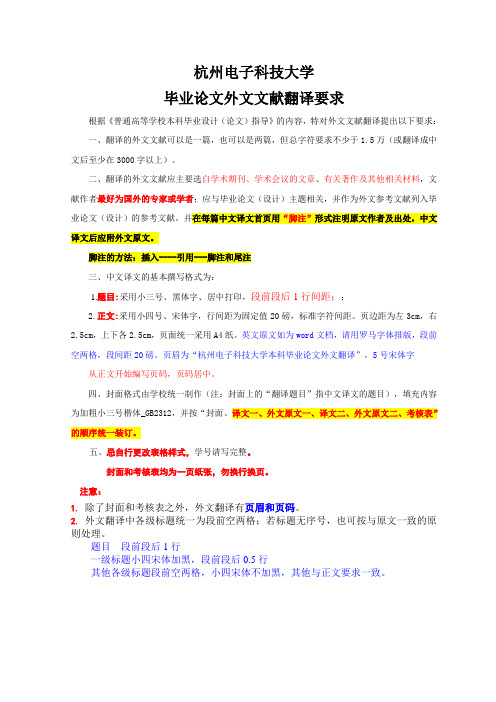
杭州电子科技大学毕业论文外文文献翻译要求根据《普通高等学校本科毕业设计(论文)指导》的内容,特对外文文献翻译提出以下要求:一、翻译的外文文献可以是一篇,也可以是两篇,但总字符要求不少于1.5万(或翻译成中文后至少在3000字以上)。
二、翻译的外文文献应主要选自学术期刊、学术会议的文章、有关著作及其他相关材料,文献作者最好为国外的专家或学者;应与毕业论文(设计)主题相关,并作为外文参考文献列入毕业论文(设计)的参考文献。
并在每篇中文译文首页用“脚注”形式注明原文作者及出处,中文译文后应附外文原文。
脚注的方法:插入----引用---脚注和尾注三、中文译文的基本撰写格式为:1.题目:采用小三号、黑体字、居中打印,段前段后1行间距;;2.正文:采用小四号、宋体字,行间距为固定值20磅,标准字符间距。
页边距为左3cm,右2.5cm,上下各2.5cm,页面统一采用A4纸。
英文原文如为word文档,请用罗马字体排版,段前空两格,段间距20磅。
页眉为“杭州电子科技大学本科毕业论文外文翻译”,5号宋体字从正文开始编写页码,页码居中。
四、封面格式由学校统一制作(注:封面上的“翻译题目”指中文译文的题目),填充内容为加粗小三号楷体_GB2312,并按“封面、译文一、外文原文一、译文二、外文原文二、考核表”的顺序统一装订。
五、忌自行更改表格样式,学号请写完整。
封面和考核表均为一页纸张,勿换行换页。
注意:1.除了封面和考核表之外,外文翻译有页眉和页码。
2.外文翻译中各级标题统一为段前空两格;若标题无序号,也可按与原文一致的原则处理。
题目段前段后1行一级标题小四宋体加黑,段前段后0.5行其他各级标题段前空两格,小四宋体不加黑,其他与正文要求一致。
毕业论文外文文献翻译毕业设计(论文)题目Xxx(单击此处添加论文题目)翻译(1)题目指翻译后的第一篇中文译文的题目翻译(2)题目指翻译后的第二篇中文译文的题目若无,则本栏留空学院经贸学院专业国际经济与贸易(单击此处添加专业)姓名XXXXXX(单击此处添加姓名)班级XX020811(单击此处添加班级)学号XX023101(单击此处添加班级)指导教师XXXXXX(单击此处添加指导教师)单击此处添加翻译后的第一篇中文译文的题目1 [单击此处添加译文正文]一、单击此处添加一级标题1[单击此处添加译文正文]1.[单击此处添加译文正文]2.[单击此处添加译文正文]3.[单击此处添加译文正文]二、单击此处添加一级标题2[单击此处添加译文正文]1.[单击此处添加译文正文]2.[单击此处添加译文正文]3.[单击此处添加译文正文]三、单击此处添加一级标题3……………………………以下是模板的使用方法说明文字,正式成文后请删除。
毕业论文外文翻译要求
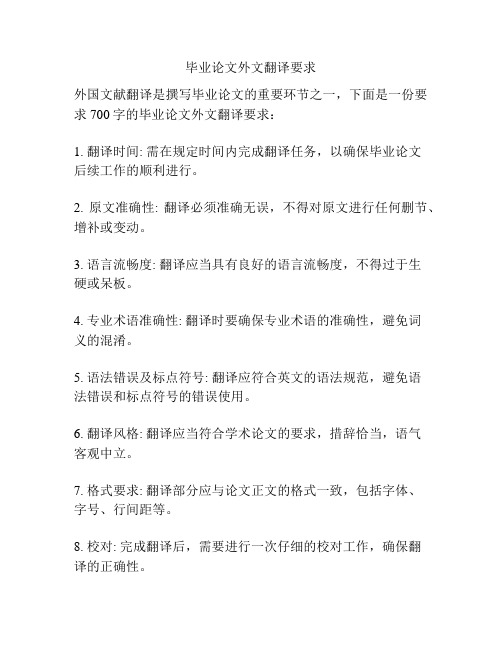
毕业论文外文翻译要求
外国文献翻译是撰写毕业论文的重要环节之一,下面是一份要求700字的毕业论文外文翻译要求:
1. 翻译时间: 需在规定时间内完成翻译任务,以确保毕业论文
后续工作的顺利进行。
2. 原文准确性: 翻译必须准确无误,不得对原文进行任何删节、增补或变动。
3. 语言流畅度: 翻译应当具有良好的语言流畅度,不得过于生
硬或呆板。
4. 专业术语准确性: 翻译时要确保专业术语的准确性,避免词
义的混淆。
5. 语法错误及标点符号: 翻译应符合英文的语法规范,避免语
法错误和标点符号的错误使用。
6. 翻译风格: 翻译应当符合学术论文的要求,措辞恰当,语气
客观中立。
7. 格式要求: 翻译部分应与论文正文的格式一致,包括字体、
字号、行间距等。
8. 校对: 完成翻译后,需要进行一次仔细的校对工作,确保翻
译的正确性。
9. 原文附录: 翻译部分要同时附上原文,以便审查人员对翻译的准确性进行核对。
10. 翻译文档: 翻译文档要以电子文档的形式提交,确保方便审查人员查看。
以上要求旨在保证翻译的质量和准确性,对于撰写毕业论文非常重要。
翻译过程中,建议使用专业的翻译工具,如翻译记忆软件、专业词典等,以提高翻译的效率和准确性。
同时,积极与导师和专业领域的人进行交流和讨论,以解决翻译中的问题和困惑。
毕业设计(论文)外文翻译【范本模板】
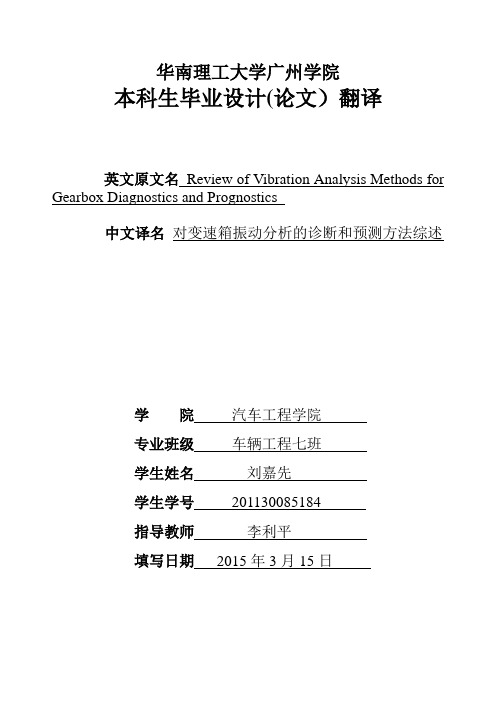
华南理工大学广州学院本科生毕业设计(论文)翻译英文原文名Review of Vibration Analysis Methods for Gearbox Diagnostics and Prognostics中文译名对变速箱振动分析的诊断和预测方法综述学院汽车工程学院专业班级车辆工程七班学生姓名刘嘉先学生学号201130085184指导教师李利平填写日期2015年3月15日英文原文版出处:Proceedings of the 54th Meeting of the Society for Machinery Failure Prevention Technology, Virginia Beach,V A, May 1-4,2000,p. 623-634译文成绩:指导教师(导师组长)签名:译文:简介特征提取技术在文献中有描述;然而,大多数人似乎掩盖所需的特定的预处理功能。
一些文件没有提供足够的细节重现他们的结果,并没有一个全面的比较传统的功能过渡齿轮箱数据。
常用术语,如“残差信号”,是指在不同的文件不同的技术.试图定义了状态维修社区中的常用术语和建立所需的特定的预处理加工特性。
本文的重点是对所使用的齿轮故障检测功能。
功能分为五个不同的组基于预处理的需要。
论文的第一部分将提供预处理流程的概述和其中每个特性计算的处理方案。
在下一节中,为特征提取技术描述,将更详细地讨论每一个功能。
最后一节将简要概述的宾夕法尼亚州立大学陆军研究实验室的CBM工具箱用于齿轮故障诊断。
特征提取概述许多类型的缺陷或损伤会增加机械振动水平。
这些振动水平,然后由加速度转换为电信号进行数据测量。
原则上,关于受监视的计算机的健康的信息被包含在这个振动签名。
因此,新的或当前振动签名可以与以前的签名进行比较,以确定该元件是否正常行为或显示故障的迹象。
在实践中,这种比较是不能奏效的。
由于大的变型中,签名的直接比较是困难的。
相反,一个涉及从所述振动署名数据特征提取更多有用的技术也可以使用。
毕业设计论文中英文翻译要求(最新)
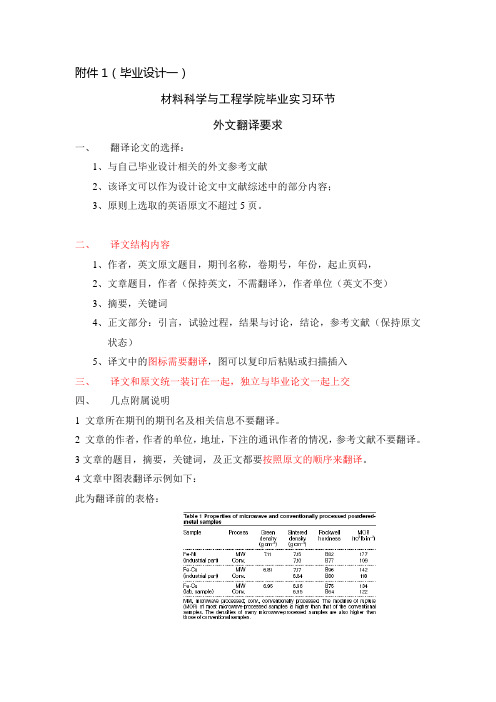
附件1(毕业设计一)材料科学与工程学院毕业实习环节外文翻译要求一、翻译论文的选择:1、与自己毕业设计相关的外文参考文献2、该译文可以作为设计论文中文献综述中的部分内容;3、原则上选取的英语原文不超过5页。
二、译文结构内容1、作者,英文原文题目,期刊名称,卷期号,年份,起止页码,2、文章题目,作者(保持英文,不需翻译),作者单位(英文不变)3、摘要,关键词4、正文部分:引言,试验过程,结果与讨论,结论,参考文献(保持原文状态)5、译文中的图标需要翻译,图可以复印后粘贴或扫描插入三、译文和原文统一装订在一起,独立与毕业论文一起上交四、几点附属说明1 文章所在期刊的期刊名及相关信息不要翻译。
2 文章的作者,作者的单位,地址,下注的通讯作者的情况,参考文献不要翻译。
3文章的题目,摘要,关键词,及正文都要按照原文的顺序来翻译。
4文章中图表翻译示例如下:此为翻译前的表格:此为翻译后的表格:表1 微波和常规方法加工的粉体金属样品的性能Table 1 Properties of microwave and conventionally processedpowdered metal samplesMW 代表微波烧结;conv代表常规方法。
大部分微波烧结的样品的断裂模量比常规方法烧结的要高。
许多微波烧结的样品的密度也是高于常规方法烧成的样品。
MW, microwave processed; conv., conventionally processed. Themodulus of rupture(MOR) of most microwave-processed samples ishigher than that of the conventional samples. The densities of manymicrowave-processed samples are also higher than those ofconventional samples.即表头和注释中英文都要。
超详细外文翻译模板及写法

XX学院毕业论文(设计)外文翻译撰写格式规范一、外文翻译形式要求1、要求本科生毕业论文(设计)外文翻译部分的外文字符不少于1.5万字, 每篇外文文献翻译的中文字数要求达到2000字以上,一般以2000~3000字左右为宜。
2、翻译的外文文献应主要选自学术期刊、学术会议的文章、有关著作及其他相关材料,应与毕业论文(设计)主题相关,并作为外文参考文献列入毕业论文(设计)的参考文献。
3、外文翻译应包括外文文献原文和译文,译文要符合外文格式规范和翻译习惯。
二、打印格式XX学院毕业论文(设计)外文翻译打印纸张统一用A4复印纸,页面设置:上:2.8;下:2.6;左:3.0;右:2.6;页眉:1.5;页脚:1.75。
段落格式为:1.5倍行距,段前、段后均为0磅。
页脚设置为:插入页码,居中。
具体格式见下页温馨提示:正式提交“XX学院毕业论文(设计)外文翻译”时请删除本文本中说明性的文字部分(红字部分)。
XX学院毕业论文(设计)外文翻译题目:系别:服装与艺术设计系专业:班级:学号:学生姓名:一、外文原文见附件(文件名:12位学号+学生姓名+3外文原文.文件扩展名)。
二、翻译文章翻译文章题目(黑体小三号,1.5倍行距,居中)作者(用原文,不需翻译,Times New Roman五号,加粗,1.5倍行距,居中)工作单位(用原文,不需翻译,Times New Roman五号,1.5倍行距,居中)摘要:由于消费者的需求和汽车市场竞争力的提高,汽车检测标准越来越高。
现在车辆生产必须长于之前的时间并允许更高的价格进行连续转售……。
(内容采用宋体五号,1.5倍行距)关键词:汽车产业纺织品,测试,控制,标准,材料的耐用性1 导言(一级标题,黑体五号,1.5倍行距,顶格)缩进两个字符,文本主体内容采用宋体(五号),1.5倍行距参考文献(一级标题,黑体五号, 1.5倍行距,顶格)略(参考文献不需翻译,可省略)资料来源:AUTEX Research Journal, Vol. 5, No3, September 2008*****译****校(另起一页)三、指导教师评语***同学是否能按时完成外文翻译工作。
毕业论文翻译要求
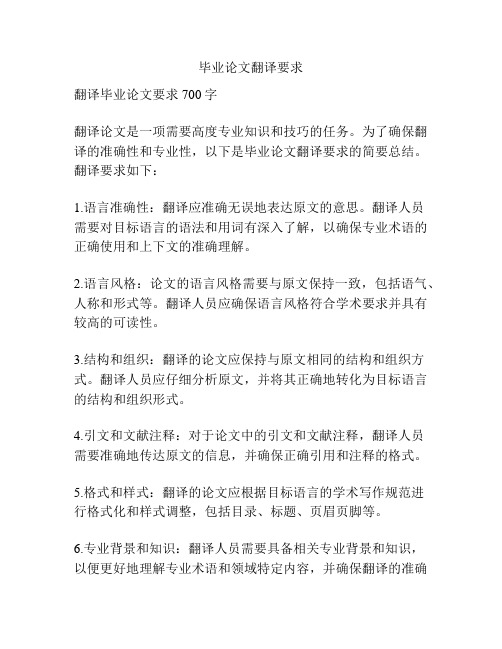
毕业论文翻译要求
翻译毕业论文要求700字
翻译论文是一项需要高度专业知识和技巧的任务。
为了确保翻译的准确性和专业性,以下是毕业论文翻译要求的简要总结。
翻译要求如下:
1.语言准确性:翻译应准确无误地表达原文的意思。
翻译人员
需要对目标语言的语法和用词有深入了解,以确保专业术语的正确使用和上下文的准确理解。
2.语言风格:论文的语言风格需要与原文保持一致,包括语气、人称和形式等。
翻译人员应确保语言风格符合学术要求并具有较高的可读性。
3.结构和组织:翻译的论文应保持与原文相同的结构和组织方式。
翻译人员应仔细分析原文,并将其正确地转化为目标语言的结构和组织形式。
4.引文和文献注释:对于论文中的引文和文献注释,翻译人员
需要准确地传达原文的信息,并确保正确引用和注释的格式。
5.格式和样式:翻译的论文应根据目标语言的学术写作规范进
行格式化和样式调整,包括目录、标题、页眉页脚等。
6.专业背景和知识:翻译人员需要具备相关专业背景和知识,
以便更好地理解专业术语和领域特定内容,并确保翻译的准确
性。
7.逻辑和连贯性:翻译的论文应保持逻辑和连贯性,以确保文章的流畅阅读和理解。
8.润色和校对:翻译的论文应进行润色和校对,以纠正语法、拼写和标点等错误,并确保整个论文的准确性和一致性。
9.保密性:翻译人员需要确保论文的保密性,并遵守相关机构和机构的保密政策。
总之,翻译毕业论文需要高度的专业知识和技巧。
翻译人员应确保翻译的准确性、专业性和一致性,并按照学术写作规范进行格式化和样式调整,以确保最终翻译的论文符合学术要求。
毕业论文的外文翻译要求
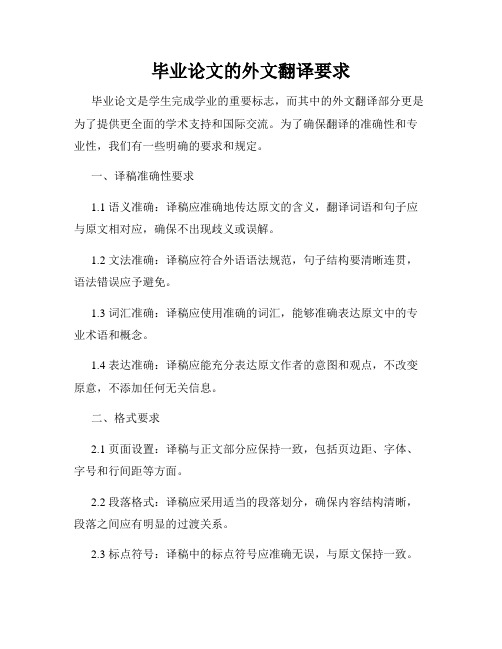
毕业论文的外文翻译要求毕业论文是学生完成学业的重要标志,而其中的外文翻译部分更是为了提供更全面的学术支持和国际交流。
为了确保翻译的准确性和专业性,我们有一些明确的要求和规定。
一、译稿准确性要求1.1 语义准确:译稿应准确地传达原文的含义,翻译词语和句子应与原文相对应,确保不出现歧义或误解。
1.2 文法准确:译稿应符合外语语法规范,句子结构要清晰连贯,语法错误应予避免。
1.3 词汇准确:译稿应使用准确的词汇,能够准确表达原文中的专业术语和概念。
1.4 表达准确:译稿应能充分表达原文作者的意图和观点,不改变原意,不添加任何无关信息。
二、格式要求2.1 页面设置:译稿与正文部分应保持一致,包括页边距、字体、字号和行间距等方面。
2.2 段落格式:译稿应采用适当的段落划分,确保内容结构清晰,段落之间应有明显的过渡关系。
2.3 标点符号:译稿中的标点符号应准确无误,与原文保持一致。
2.4 图表翻译:如原文中包含图表、图片等内容,应准确翻译并清晰插入,保持与原文的对应关系。
三、语言风格要求3.1 学术性语言:译稿应以学术性的语言进行表达,避免使用口语或俚语词汇。
3.2 表达简明:译稿应尽量使用简明扼要的语言,避免冗长和啰嗦的表达。
3.3 文体恰当:译稿应根据原文的文体特点,保持与之一致的语言风格,如正式、客观等。
3.4 遵循学科要求:根据不同学科的要求,译稿应遵循相应的学科规范和术语。
四、参考文献要求4.1 引用准确:如译稿中涉及引用原文中的内容,应准确标注出处,遵循学术引用规范。
4.2 参考文献著录:如译稿中有参考文献部分,应按照规范的著录格式进行排版,确保引用的准确性。
4.3 翻译标注:如译稿中对参考文献进行翻译或添加注释,应将其清晰标注,以区分原文与译文。
总结:毕业论文的外文翻译要求是多方面的,从译稿准确性、格式要求、语言风格要求到参考文献要求,都需要学生严格遵循。
合理的格式和清晰的语言表达是展示学术水平和专业素养的重要方面,而译稿的准确性更是毕业论文的基石。
毕业论文英文翻译要求(通用版)(范文模版)

毕业论文英文翻译要求(通用版)(范文模版)第一篇:毕业论文英文翻译要求(通用版)(范文模版)本科毕业设计(论文)英文翻译要求翻译的文章应与毕业设计课题或专业知识相关的文献,要求翻译1-2篇,合计中文字数不少于3000字。
外文翻译应包括:外文题目,作者、出版日期和出版社,翻译内容的起止页码,外文原文,然后是中文题目,作者、出版日期和出版社,中文翻译。
外文翻译所用的文献,应主要选自学术期刊或学术会议的文章,其次是教科书或其他书籍。
英文原文和翻译均作为毕业论文附录,同时给出英文原文的出处,如果是网上下载的原文请给出网址。
第二篇:毕业论文英文翻译武汉科技大学本科毕业设计外文翻译Automatic Statistical Process Control of a CNC Turning Centre Using Tool Offsets and Tool ChangeP.R.Gibson and K.HoangDepartment of Mechanical Engineering, University of Wollongong, Australia School of Mechanical and Manufacturing Engineering, University of New South Wales, Australia 数控车削中心刀补及换刀的自动统计过程控制P.R.Gibson and K.Hoang澳大利亚伍伦贡大学机械工程系,新威尔士大学机械制造工程学院武汉科技大学本科毕业设计外文翻译该论文涉及了自动统计过程控制(ASPC)在数控车削中刀补和换刀的自动周期测量上的运用。
由于当今制造对快速稳定的控制系统的需求,而且为了实现较高的产出率,一个闭环ASPC系统已被采用。
我们引入了自动周期测量技术,以全面测量该系统。
关键字:工艺规划;数控;车削简介今天,所有制造行业都面临着采用更加经济高效的质量控制系统,以满足客户的需求这一问题。
毕业设计(论文)外文资料和译文格式要求(模板)
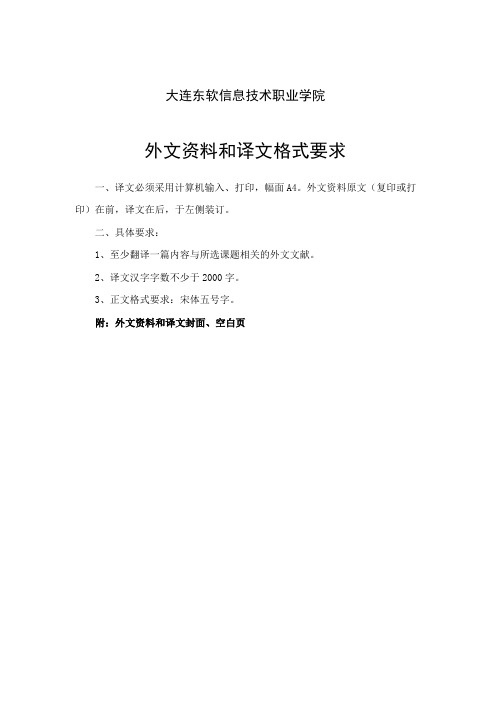
1、至少翻译一篇内容与所选课题相关的外文文献。
2、译文汉字字数不少于2000字。
3、正文格式要求:宋体五号字。
附:外文资料和译文封面、空白页
大连东软信息技术职业学院
外文资料和译文
专业:
班级:
姓名:
学号:
指要求模板毕业论文格式模板外文翻译模板外文译文java外文及译文论文格式模板毕业答辩ppt模板应届毕业生简历模板毕业生简历模板毕业论文模板
大连东软信息技术职业学院
外文资料和译文格式要求
一、译文必须采用计算机输入、打印,幅面A4。外文资料原文(复印或打印)在前,译文在后,于左侧装订。
毕业设计(论文)外文文献翻译要求
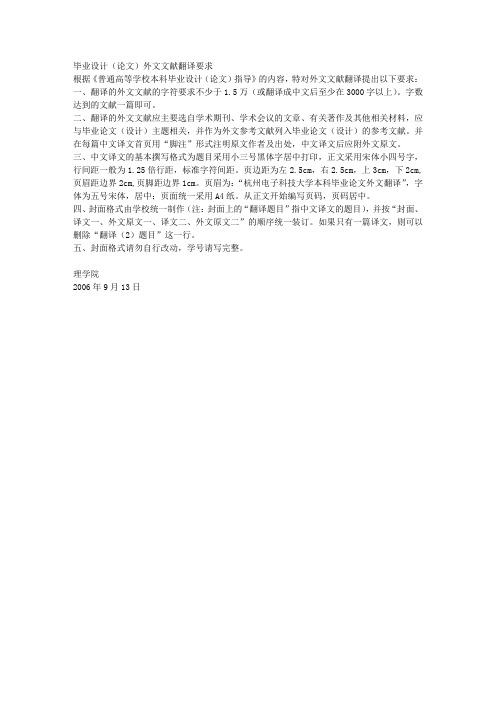
毕业设计(论文)外文文献翻译要求
根据《普通高等学校本科毕业设计(论文)指导》的内容,特对外文文献翻译提出以下要求:一、翻译的外文文献的字符要求不少于1.5万(或翻译成中文后至少在3000字以上)。
字数达到的文献一篇即可。
二、翻译的外文文献应主要选自学术期刊、学术会议的文章、有关著作及其他相关材料,应与毕业论文(设计)主题相关,并作为外文参考文献列入毕业论文(设计)的参考文献。
并在每篇中文译文首页用“脚注”形式注明原文作者及出处,中文译文后应附外文原文。
三、中文译文的基本撰写格式为题目采用小三号黑体字居中打印,正文采用宋体小四号字,行间距一般为1.25倍行距,标准字符间距。
页边距为左2.5cm,右2.5cm,上3cm,下2cm,页眉距边界2cm,页脚距边界1cm。
页眉为:“杭州电子科技大学本科毕业论文外文翻译”,字体为五号宋体,居中;页面统一采用A4纸。
从正文开始编写页码,页码居中。
四、封面格式由学校统一制作(注:封面上的“翻译题目”指中文译文的题目),并按“封面、译文一、外文原文一、译文二、外文原文二”的顺序统一装订。
如果只有一篇译文,则可以删除“翻译(2)题目”这一行。
五、封面格式请勿自行改动,学号请写完整。
理学院
2006年9月13日。
译文+格式+及+评语+要求
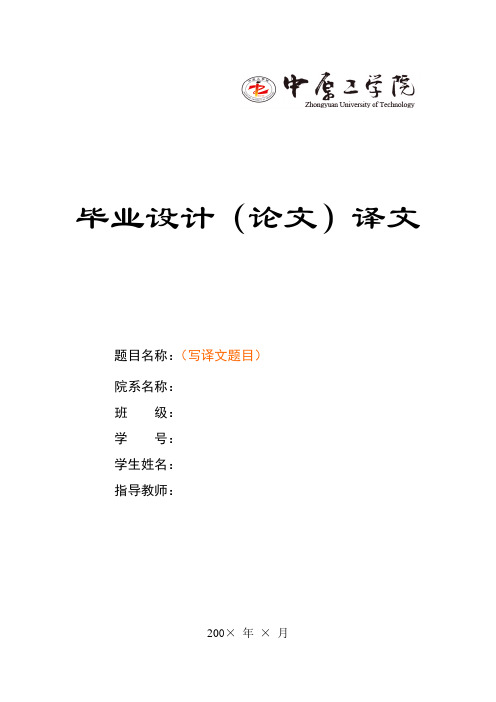
毕业设计(论文)译文题目名称:(写译文题目)院系名称:班级:学号:学生姓名:指导教师:200×年×月指导教师批改要求:1.译文工作是把外文翻译为中文,选题必须与论文方向一致,外文作者应为外国作者,中英文内容相互对应。
2.在中英文结尾处均标明原文出处,标注方法见附例。
3.字数要求:3000汉字或15000个印刷符号。
4.排版要求:按照毕业论文正文要求格式排版。
5.装订顺序:汉语翻译在前,英文原文在后,英文部分也可以是原文复印件。
6.教师应根据译文内容是否与毕业论文相关、翻译是否准确、语言是否通顺、逻辑是否合理等方面对毕业生的翻译工作质量给出评价,写出100字左右的评语,并签名。
请用红笔书写。
7.译文不单独计分,与毕业论文(设计)一并综合评分。
附例:风险导向审计研究Pie Pierce, B., Sweeney, B.近几年来,审计行业面临的风险正在日益增大,国内外相继出现了一些会计舞弊事件,如:美国的“安然”、“施乐”,国内的“原野”、“琼民源”、“红光”等,审计人员由此涉及的案件也成千上万,赔偿的金额更难以估计,甚至有人称审计职业界进入了“诉讼爆炸”时代,一些会计师事务所因诉讼而倒闭或陷入困境,这使审计人员清醒地认识到,在商业竞争十分激烈的市场经济中,审计职业界所面临的商业风险已越来越大,审计职业必须设法降低这种商业风险水平。
为此,以美国为首的西方国家从20世纪80年代开始大规模地修订审计准则,在实践中产生了一种以风险评价为中心的审计模式,并在实务中得到广泛应用。
一、风险导向审计产生的社会基础(一)高风险的审计执业环境是风险导向审计产生的直接原因。
众多企业的倒闭,已审报表的使用者将经营失败等同于审计失败。
他们认为企业濒临破产,注册会计师进行财务报表审计时就应提前发出警告,这样审计人员与公众期望的差距越来越大。
期望差距的加大,表明社会公众对审计的需求日益增加,为弥补审计期望差距就得寻找途径,主动出击,迎合这种需求,须承担一定的法律责任——即承担更大的查错防弊责任。
毕业设计(论文)与译文要求
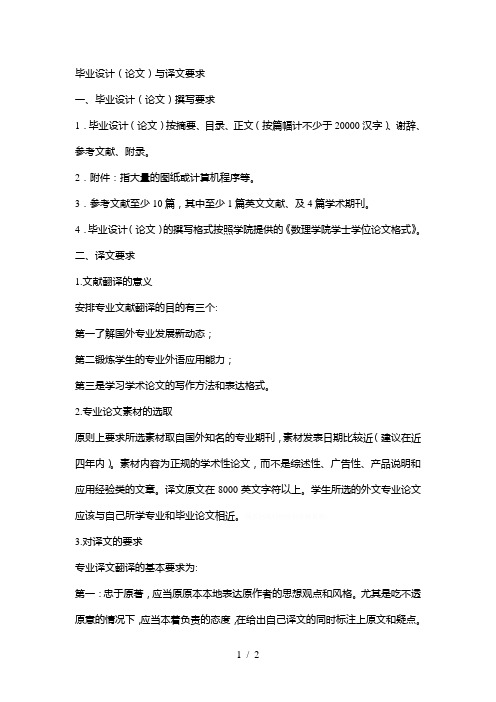
毕业设计(论文)与译文要求一、毕业设计(论文)撰写要求1.毕业设计(论文)按摘要、目录、正文(按篇幅计不少于20000汉字)、谢辞、参考文献、附录。
2.附件:指大量的图纸或计算机程序等。
3.参考文献至少10篇,其中至少1篇英文文献、及4篇学术期刊。
4.毕业设计(论文)的撰写格式按照学院提供的《数理学院学士学位论文格式》。
二、译文要求1.文献翻译的意义安排专业文献翻译的目的有三个:第一了解国外专业发展新动态;第二锻炼学生的专业外语应用能力;第三是学习学术论文的写作方法和表达格式。
2.专业论文素材的选取原则上要求所选素材取自国外知名的专业期刊,素材发表日期比较近(建议在近四年内)。
素材内容为正规的学术性论文,而不是综述性、广告性、产品说明和应用经验类的文章。
译文原文在8000英文字符以上。
学生所选的外文专业论文应该与自己所学专业和毕业论文相近。
3.对译文的要求专业译文翻译的基本要求为:第一:忠于原著,应当原原本本地表达原作者的思想观点和风格。
尤其是吃不透原意的情况下,应当本着负责的态度,在给出自己译文的同时标注上原文和疑点。
第二:在语言文字表达上尽量做到最合适的表达,使得读者可在第一时间领会其含义,必须要采用自己专业的术语。
第三:译文的题目、小标题、摘要、关键词和图名都应译出。
图中的文字也应译出。
图可复印后贴在译文上。
参考文献不译。
第四:专业译文作品提交时应附上原文的复印件,以便评审。
第五:学生在选材时可选用我院图书馆已订的专业英文期刊,也可自定选材,但选材必须是学术性论文。
4. 译文的格式参照《专业译文》模板,译文原文可以打印,也可以复印。
三、时间要求递交专业译文的时间与每学期毕业论文开题报告同时交。
毕业设计外文翻译要求
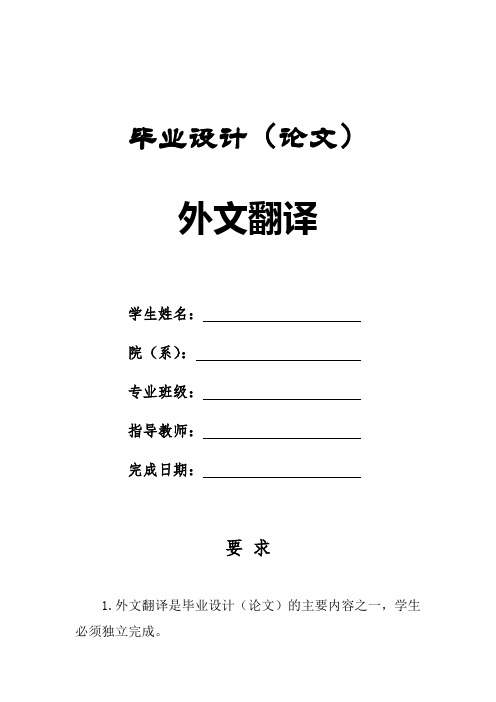
毕业设计(论文)
外文翻译
学生姓名:
院(系):
专业班级:
指导教师:
完成日期:
要求
1.外文翻译是毕业设计(论文)的主要内容之一,学生必须独立完成。
2.外文翻译文内容应与学生的专业或毕业设计(论文)内容相关,不得少于15000印刷字符。
3.外文翻译文用A4纸打印。
文章标题用3号宋体,章节标题用4号宋体,正文用小4号宋体;页边距上下左右均为2.5cm,左侧装订,装订线0.5cm。
按中文翻译在上,外文原文在下的顺序装订。
4.年月日等的填写,用阿拉伯数字书写,要符合《关于出版物上数字用法的试行规定》,如“2009年2月15日”。
5.所有签名必须手写,不得打印。
毕业设计(论文)外文资料及译文(模板)
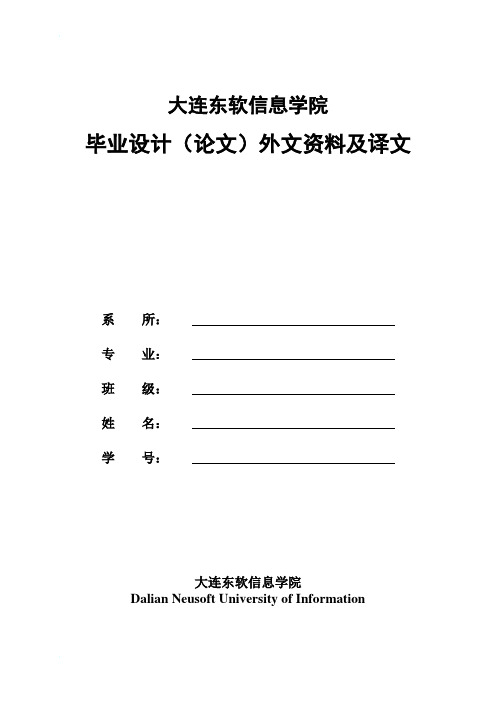
大连东软信息学院
毕业设计(论文)外文资料及译文
系所:
专业:
班级:
姓名:
学号:
大连东软信息学院
Dalian Neusoft University of Information
外文资料和译文格式要求
一、装订要求
1、外文资料原文(复印或打印)在前、译文在后、最后为指导教师评定成绩。
2、译文必须采用计算机输入、打印。
3、A4幅面打印,于左侧装订。
二、撰写要求
1、外文文献内容与所选课题相关。
2、本科学生译文汉字字数不少于4000字,高职学生译文汉字字数不少于2000字。
三、格式要求
1、译文字号:中文小四号宋体,英文小四号“Times New Roman”字型,全文统一,首行缩进2个中文字符,1.5倍行距。
2、译文页码:页码用阿拉伯数字连续编页,字体采用“Times New Roman”字体,字号小五,页底居中。
3、译文页眉:眉体使用单线,页眉说明五号宋体,居中“大连东软信息学院本科毕业设计(论文)译文”。
大连东软信息学院毕业设计(论文)译文
大连东软信息学院毕业设计(论文)译文
大连东软信息学院毕业设计(论文)译文
大连东软信息学院毕业设计(论文)译文
大连东软信息学院毕业设计(论文)译文。
毕业设计外文翻译撰写格式规范

嘉兴学院(南湖学院)毕业论文(设计)外文翻译撰写格式规范一、外文翻译形式要求1、要求本科生毕业论文(设计)外文翻译部分的外文字符不少于1.5万字, 每篇外文文献翻译的中文字数要求达到2000字以上,一般以2000~3000字左右为宜。
2、翻译的外文文献应主要选自学术期刊、学术会议的文章、有关著作及其他相关材料,应与毕业论文(设计)主题相关,并作为外文参考文献列入毕业论文(设计)的参考文献。
3、外文翻译应包括外文文献原文和译文,译文要符合外文格式规范和翻译习惯。
二、打印格式嘉兴学院(南湖学院)毕业论文(设计)外文翻译打印纸张统一用A4复印纸,页面设置:上:2.8;下:2.6;左:3.0;右:2.6;页眉:1.5;页脚:1.75。
段落格式为:1.5倍行距,段前、段后均为0磅。
页脚设置为:插入页码,居中。
具体格式见下页温馨提示:正式提交“嘉兴学院(南湖学院)毕业论文(设计)外文翻译”时请删除本文本中说明性的文字部分(红字部分)。
文档标题采用楷体_GB2312,三号字体,加粗,居中。
一级标题采用楷体_GB2312,四号字体,加粗,左侧顶格。
二级标题采用宋体,小四号字体,加粗,缩进两个中文字符。
三级标题采用宋体,五号字体,缩进两个中文字符。
正文采用五号宋体字,数字用阿拉伯数字,字母和数字用Times New Roman。
嘉兴学院(南湖学院)毕业设计外文翻译题目:系别:专业:班级:学号:学生姓名:一、外文摘要及关键词英文文章题目(Times New Roman小三号,1.5倍行距,居中)(作者工作单位,省略)ABSTRACT:(Times New Roman小四号加粗,顶格):英文原文(Times New Roman五号,1.5倍行距)KEYWORDS:(Times New Roman小四号加粗,顶格):同行接关键词,关键词之间用逗号分割,用五号Times New Roman字体。
二、中文摘要及关键词翻译文章题目(黑体小三号,1.5倍行距,居中)摘要:由于消费者的需求和汽车市场竞争力的提高,汽车检测标准越来越高。
- 1、下载文档前请自行甄别文档内容的完整性,平台不提供额外的编辑、内容补充、找答案等附加服务。
- 2、"仅部分预览"的文档,不可在线预览部分如存在完整性等问题,可反馈申请退款(可完整预览的文档不适用该条件!)。
- 3、如文档侵犯您的权益,请联系客服反馈,我们会尽快为您处理(人工客服工作时间:9:00-18:30)。
附件1(毕业设计一)
材料科学与工程学院毕业实习环节
外文翻译要求
一、翻译论文的选择:
1、与自己毕业设计相关的外文参考文献
2、该译文可以作为设计论文中文献综述中的部分内容;
3、原则上选取的英语原文不超过5页。
二、译文结构内容
1、作者,英文原文题目,期刊名称,卷期号,年份,起止页码,
2、文章题目,作者(保持英文,不需翻译),作者单位(英文不变)
3、摘要,关键词
4、正文部分:引言,试验过程,结果与讨论,结论,参考文献(保持原文
状态)
5、译文中的图标需要翻译,图可以复印后粘贴或扫描插入
三、译文和原文统一装订在一起,独立与毕业论文一起上交
四、几点附属说明
1 文章所在期刊的期刊名及相关信息不要翻译。
2 文章的作者,作者的单位,地址,下注的通讯作者的情况,参考文献不要翻译。
3文章的题目,摘要,关键词,及正文都要按照原文的顺序来翻译。
4文章中图表翻译示例如下:
此为翻译前的表格:
此为翻译后的表格:
表1 微波和常规方法加工的粉体金属样品的性能
Table 1 Properties of microwave and conventionally processed
powdered metal samples
MW 代表微波烧结;conv代表常规方法。
大部分微波烧结的
样品的断裂模量比常规方法烧结的要高。
许多微波烧结的样品
的密度也是高于常规方法烧成的样品。
MW, microwave processed; conv., conventionally processed. The
modulus of rupture(MOR) of most microwave-processed samples is
higher than that of the conventional samples. The densities of many
microwave-processed samples are also higher than those of
conventional samples.
即表头和注释中英文都要。
表中其它插入的内容不要翻译。
图片也是如此。
